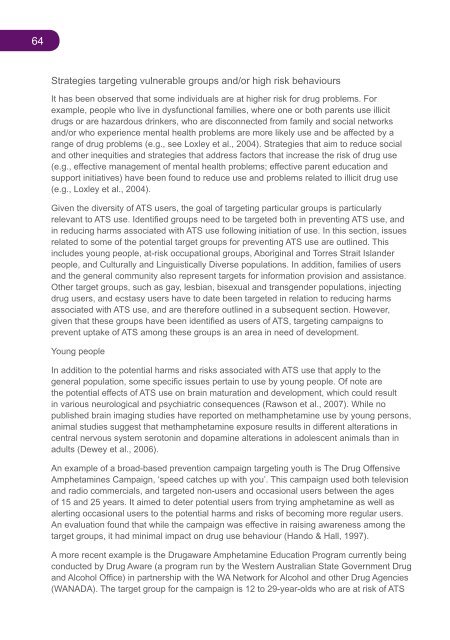National Amphetamine-Type Stimulant Strategy Background Paper
National Amphetamine-Type Stimulant Strategy Background Paper
National Amphetamine-Type Stimulant Strategy Background Paper
Create successful ePaper yourself
Turn your PDF publications into a flip-book with our unique Google optimized e-Paper software.
64<br />
Strategies targeting vulnerable groups and/or high risk behaviours<br />
It has been observed that some individuals are at higher risk for drug problems. For<br />
example, people who live in dysfunctional families, where one or both parents use illicit<br />
drugs or are hazardous drinkers, who are disconnected from family and social networks<br />
and/or who experience mental health problems are more likely use and be affected by a<br />
range of drug problems (e.g., see Loxley et al., 2004). Strategies that aim to reduce social<br />
and other inequities and strategies that address factors that increase the risk of drug use<br />
(e.g., effective management of mental health problems; effective parent education and<br />
support initiatives) have been found to reduce use and problems related to illicit drug use<br />
(e.g., Loxley et al., 2004).<br />
Given the diversity of ATS users, the goal of targeting particular groups is particularly<br />
relevant to ATS use. Identified groups need to be targeted both in preventing ATS use, and<br />
in reducing harms associated with ATS use following initiation of use. In this section, issues<br />
related to some of the potential target groups for preventing ATS use are outlined. This<br />
includes young people, at-risk occupational groups, Aboriginal and Torres Strait Islander<br />
people, and Culturally and Linguistically Diverse populations. In addition, families of users<br />
and the general community also represent targets for information provision and assistance.<br />
Other target groups, such as gay, lesbian, bisexual and transgender populations, injecting<br />
drug users, and ecstasy users have to date been targeted in relation to reducing harms<br />
associated with ATS use, and are therefore outlined in a subsequent section. However,<br />
given that these groups have been identified as users of ATS, targeting campaigns to<br />
prevent uptake of ATS among these groups is an area in need of development.<br />
Young people<br />
In addition to the potential harms and risks associated with ATS use that apply to the<br />
general population, some specific issues pertain to use by young people. Of note are<br />
the potential effects of ATS use on brain maturation and development, which could result<br />
in various neurological and psychiatric consequences (Rawson et al., 2007). While no<br />
published brain imaging studies have reported on methamphetamine use by young persons,<br />
animal studies suggest that methamphetamine exposure results in different alterations in<br />
central nervous system serotonin and dopamine alterations in adolescent animals than in<br />
adults (Dewey et al., 2006).<br />
An example of a broad-based prevention campaign targeting youth is The Drug Offensive<br />
<strong>Amphetamine</strong>s Campaign, ‘speed catches up with you’. This campaign used both television<br />
and radio commercials, and targeted non-users and occasional users between the ages<br />
of 15 and 25 years. It aimed to deter potential users from trying amphetamine as well as<br />
alerting occasional users to the potential harms and risks of becoming more regular users.<br />
An evaluation found that while the campaign was effective in raising awareness among the<br />
target groups, it had minimal impact on drug use behaviour (Hando & Hall, 1997).<br />
A more recent example is the Drugaware <strong>Amphetamine</strong> Education Program currently being<br />
conducted by Drug Aware (a program run by the Western Australian State Government Drug<br />
and Alcohol Office) in partnership with the WA Network for Alcohol and other Drug Agencies<br />
(WANADA). The target group for the campaign is 12 to 29-year-olds who are at risk of ATS

















